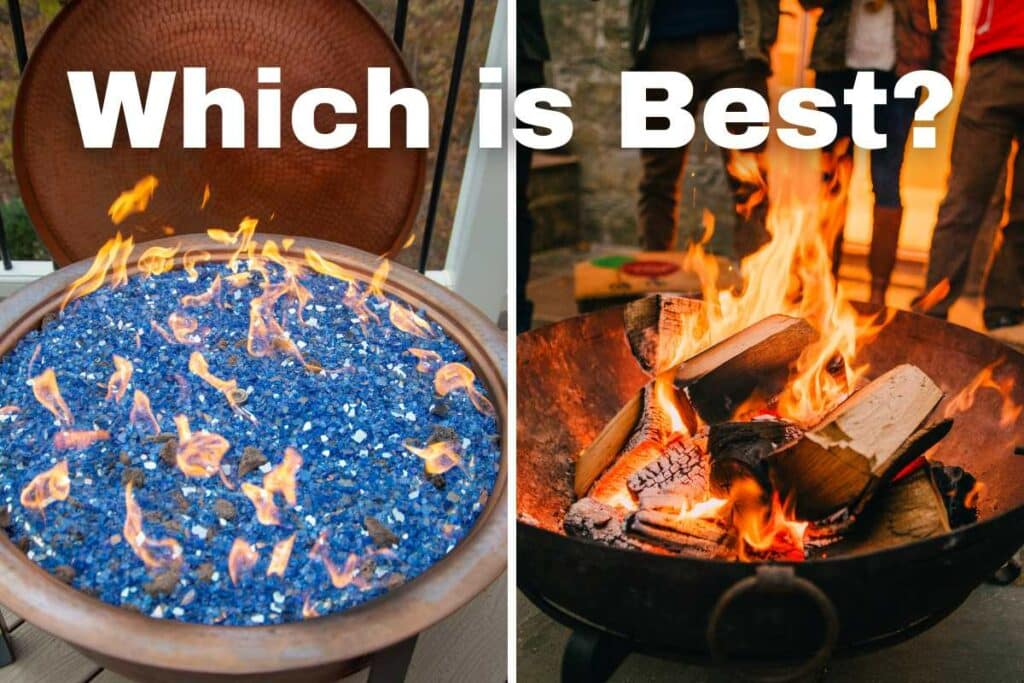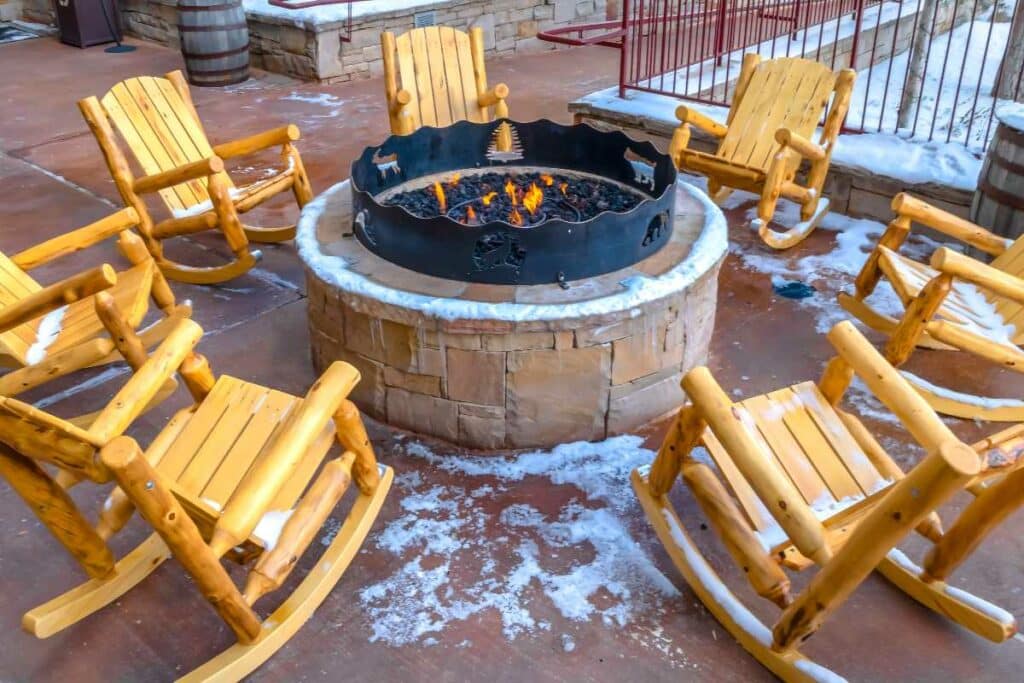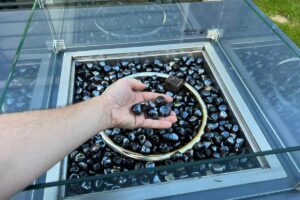
An outdoor fireplace or firepit has become all the rage in today’s landscape designs. The outdoor space can hardly be called complete without a fire feature. But the choice between a wood-burning and a gas fire pit can often be a tough one to make.
Many homeowners appreciate the crackling charm and affordability of a wood fire pit. However, the convenience and quick start-up of a gas feature can often be too enticing. So, what’s the better option?
Today, we compare the two most popular types of fire pits: wood-burning vs propane fire pits. We’ll look at their installation differences, maintenance, the costs involved, and more.
Let’s jump right into it.
Propane Fire Pit

Flame King Smokeless Propane Fire Pit
24-INCH PORTABLE FIRE PIT BOWL with a heat output of 58,000 BTUs
Wood Fire Pit

UDPATIO Fire Pit
A durable heavy-duty steel cooking grate can swivels 360 degrees, making swing it left or right possible.
Propane vs. Wood Fire Pits
The main difference between propane and wood fire pits lies in the type of fuel they utilize.
Propane fire pits are powered by propane gas. They are commonly constructed using materials like fiber-reinforced concrete, steel, or natural stone. These fire pits typically include a burner and fire media housed in a pan.
A gas line and fittings connect the propane gas tank to the burner. A creative solution is often used to conceal the propane tank from view. The tank also needs to be replenished once its days of use end.
Many propane fire pits have an automatic ignition system for easy startup.
In contrast, wood fire pits rely on wood, particularly hardwoods, as their fuel source. Paper or fatwood fire starters and kindling are used to get the fire going.
Once the flame is established, the burning wood is able to reach high temperatures, outputting a substantial amount of heat. The heat output of a gas feature pales in comparison to wood-burning firepits.
Wood-burning fire pits can be constructed from materials such as steel, concrete, or natural stone. Fire bricks or a steel ring are often used to line the inner walls of the pit, providing insulation from the intense heat.
Portable fire pits are also available for purchase. These lightweight features are typically made of heat-resistant steel and utilize three or four stands for support. Wood fire pits are typically larger to accommodate larger logs.
While hardwoods such as oak are widely available in many regions of the US and Canada, they may be difficult or expensive to obtain in certain parts. In regions where hardwood is scarce, softwoods like pine can serve as an alternative.
The wood needs to be stacked and stored on a raised platform away from damp soil and under-cover to protect them from inclement weather. Proper wood storage is essential to keep those logs dry and safe from pesky termites.
Installation
Gas fire pits can be quite demanding and intricate compared to wood fire pits as far as installation and know-how involved.
You see, gas fire pits require the connection of a gas line from the propane tank to the burner. You’ll need to install valves, burners, thermocouples, or thermopiles for the ignition systems, fittings, and couplings among other components. Lest we forget about the pan and fire pit media, like ceramic log sets, fire glass, or fireballs, and hiding the propane tank from view.
Because of all these technicalities, it’s often best to seek professional assistance for propane fire pits. Gas fire pits offer more options overall, but they’re more complex and costlier to install.
Nonetheless, this can still be undertaken as a DIY project with the proper installation guidelines.

Now, let’s look at wood fire pits—they’re easier to install and friendlier on the pocket. What’s more, they make for a great DIY project. For this, you need masonry products like precast pavers, natural stone, wall blocks, fireproof bricks, and a heat-resistant steel ring for construction.
You may need to do some customized cutting and top off the feature with a stone cap and/or fire ring.
Efficiency & Heat Output
Propane fire pits are more fuel efficient than wood fire pits. They produce fewer emissions, soot, and creosote. Gas fire pits burn cleaner and do not produce physical waste like ash.
Wood fire pits, especially if not well designed or when using the wrong type of wood, can produce a significant amount of smoke, soot, creosote, and ash. While ash can be repurposed for gardening or other uses, soot and creosote often leave a lingering smell.
Although wood fire pits burn hotter, gas fire pits can also provide ample warmth. This depends on the fire media used, the size of the burner, the angle of the jets, the weather, and the size of the space to warm.
If heat output is the primary concern, stick to a wood-burning fire pit. Cooking outdoors is also more convenient with wood-burning setups due to the higher heat output.
Cost
Cost is the main factor that sets apart wood-burning and gas fire pits.
The initial installation of a wood fire pit typically ranges from $700 to $2,000, with material and installation costs included. Due to budget constraints, many people opt for wood-burning fire pits.
Gas fire pits, on the other hand, can cost between $2,500 and $8,000 or more, depending on the materials used, and project complexity.
The higher cost is due to the requirements for a gas line hookup, couplers, fittings, elbows, burners, igniters, fire media, and other components of the feature. The terrain and layout of your backyard also impact the overall cost.
Maintenance Needs
Wood fire pits generally require more maintenance since they tend to accumulate ash, soot, and creosote, necessitating regular removal and cleaning.
In contrast, gas fire pits are quite easy to maintain apart from the occasional wiping of the pan, refilling of the propane tank, and regular inspection for leaks.
Safety Considerations
In general, gas fire pits are considered safer than wood fire pits since they offer more precise control over the fuel and flame. They burn cleanly without the need for continuously feeding wood or other materials.
Unlike wood fire pits, there are no flying sparks or unpredictable flames to worry about. Gas fire pits are usually equipped with integrated pilot systems, flame sensors, and automatic shutoff systems, providing an added level of protection.
However, improper operation can still pose a significant risk, so it is important to follow the manufacturer’s guidelines to the letter. Although the chances are slim, there is always a risk of gas leaks if not properly installed.
Wood fire pits are not inherently dangerous, but safe burning conditions must be ensured, especially in dry and windy regions. Never leave the fire unattended to prevent potential flare-ups especially with children and pets running around.
Safety should never be compromised with any kind of fire feature.
Permits
Local ordinances and restrictions may be in place in your part of the country, especially where wood-burning fire pits are involved. Gas fire pits generally require permits due to the potential dangers associated with propane tanks and gas leaks, necessitating official approval.
The legal requirements vary depending on your location. It is essential to check your zoning and HOA codes to ensure compliance.
Can You Burn Gas and Wood in the Same Fire Pit?
I would advise against burning wood in a gas fire pit.
Gas fire pits are designed specifically to hold gas burners and cannot handle the heat produced by burning wood. Attempting to burn wood in a gas fire pit can cause the pan casting to crack and compromise the integrity of the burner or gas jets.
The only option to combine wood-burning and gas fire pits is using a gas starter or pilot for ignition of the wood pile. But it is advisable to explore alternative methods for starting wood-burning fires, such as using fatwood starters and kindling wood such as pine. An electric starter can also come in handy.
You may also like ?
-
15 Best Vegetable Garden Ideas
-
How To Design The Perfect Vegetable Garden Layout
-
How And When To Fertilize Your Vegetable Garden Naturally
-
The 22 Best Fall Flowers For Your Garden
-
11 Plants Perfect for Attracting Pollinators to Your Garden
-
How To Use Plant Hardiness Zones Info To Garden Successfully
-
New Mexico Plant Hardiness Zones Map And Gardening Guide
-
Idaho Plant Hardiness Zones Map And Gardening Guide
Let’s sum things up ?
For convenience’s sake, gas fire pits are the clear winner. They offer simplicity and can be easily ignited by turning the key valve and automatic ignition or using a BBQ lighter. Gas fire pits also eliminate the need for frequent ash removal, chopping, and stacking wood.
In general, wood-burning fire pits are cheaper to install and output more heat. However, their maintenance and cleaning needs are higher.
Ultimately, the choice comes down to cost, installation complexity, ease of getting fuel, emissions, energy efficiency, maintenance requirements, and durability.








